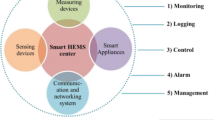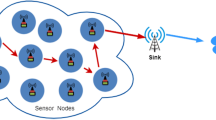Abstract
Wireless sensor networks (WSNs) suffer from energy imbalance and short lifespan among the sensor nodes placed near sink node. To optimally resolve the problem of battery of sensor nodes (SNs), many researchers have found new harvesting methods from environment or other sources, such as: solar power, vibrational energy harvesting, and magnetic resonant coupling. In this paper, we have carried out the research using three-step method. In the first step, solar based modified adhoc on-demand distance vector (Solar-MAODV) is proposed which is an improved recharging method that uses energy harvesting and congestion free routing to extend network lifetime. Also, the proposed scheme is a widely adopted combination of data collection, recharging and load balancing. Therefore, in the second step, the proposed scheme is validated by comparing its performance with existing joint mobile energy replenishment and data gathering (J-MERDG) and joint energy replenishment and load balancing (J-ERLB) techniques. Finally, in the last step, Solar-MAODV is tested on various modulation schemes to find the best modulation scheme for long range wireless rechargeable sensor networks (WRSNs). The main aim of research work is to propose robust and efficient scheme for extending lifespan of sensor nodes and to find out best modulation scheme for WRSNs so that they can support long range transmissions.





Similar content being viewed by others
References
Wei, X., Wang, Z., & Dai, H. (2014). A critical review of wireless power transfer via strongly coupled magnetic resonances. Energies, 7(7), 4316–4341.
Baghee, S., Chamanian, S., Ulusan, H., Zorlu, O., Uysal-Biyikoglu, E., & Kulah, H., (2014). Demonstration of energy-neutral operation on a WSN testbed using vibration energy harvesting, in Proceedings of the 20th European Wireless Conference (EW '14), 47–52.
Buchli, B., Sutton, F., Beutel, J., & Thiele, L., (2014). Dynamic power management for long-term energy neutral operation of solar energy harvesting systems. in Proceedings of the 12th ACM Conference, 31–45.
Rault, T., Bouabdallah, A., & Challal, Y. (2014). Energy efficiency in wireless sensor networks: A top-down survey. Computer Networks, 67, 104–122.
Hester, J., Scott, T., & Sorber, J., (2014). Ekho: realistic and repeatable experimentation for tiny energy-harvesting sensors. in Proceedings of the 12th ACM Conference on Embedded Networked Sensor Systems (SenSys '14), 1–15.
Park, J., & Clerckx, B. (2014). Joint wireless information and energy transfer in a K-user MIMO interference channel. IEEE Transactions on Wireless Communications, 13(10), 5781–5796.
Peng, S., Wang, T., & Low, C. P. (2015). Energy neutral clustering for energy harvesting wireless sensors networks. Ad Hoc Networks, 28, 1–16.
Cao, S., & Li, J. (2017). A survey on ambient energy sourcesand harvesting methods for structuralhealth monitoring applications. Advances in Mechanical Engineering, 9(4), 1–14.
Angurala, M., Bamber, S. S., Bala, M., (2017). Evaluating performance of different modulation schemes on modified cooperative aodv. International Interdisciplinary Conference on Science Technology Engineering Management Pharmacy and Humanities, 1–5.
Liu, X., Qiu, T., & Wang, T. (2019). Load-balanced data dissemination for wireless sensor networks: A nature-inspired approach. IEEE Internet of Things Journal, 6(6), 9256–9265.
Chatterjee, P., Ghosh, S. C., & Das, N. (2017). Load balanced coverage with graded node deployment in wireless sensor networks. IEEE Transactions on Multi-Scale Computing Systems, 3(2), 100–112.
Liao, Y., Qi, H., & Li, W. (2013). Load-balanced clustering algorithm with distributed self-organization for wireless sensor networks. IEEE Sensors Journal, 13(5), 1498–1506.
Chen, C., Mukhopadhyay, S. C., Chuang, C., Liu, M., & Jiang, J. (2015). Efficient coverage and connectivity preservation with load balance for wireless sensor networks. IEEE Sensors Journal, 15(1), 48–62.
Zhang, W., Wang, C., Xiao, F., Xiong, N., & Chang, J. (2019). Reliable storage system with priority filter and load balance collection model for large scale sensor networks. IEEE Access, 7, 184078–184089.
Zhao, M., Li, J., & Yang, Y. (2014). A framework of joint mobile energy replenishment and data gathering in wireless rechargeable sensor networks. IEEE Transactions on Mobile Computing, 13(12), 2689–2705.
Edla, D. R., Lipare, A., Cheruku, R., & Kuppilli, V. (2017). An efficient load balancing of gateways using improved shuffled frog leaping algorithm and novel fitness function for WSNs. IEEE Sensors Journal, 17(20), 6724–6733.
Li, X., Keegan, B., Mtenzi, F., Weise, T., & Tan, M. (2019). Energy-efficient load balancing ant based routing algorithm for wireless sensor networks. IEEE Access, 7, 113182–113196.
Yigit, M., Boluk, P. S., & Gungor, V. C. (2019). A new efficient error control algorithm for wireless sensor networks in smart grid. Computer Standards & Interfaces, 63, 27–42.
Elshrkawey, M., Elsherif, S. M., & Wahed, M. E. (2019). An enhancement approach for reducing the energy consumption in wireless sensor networks. Journal of King Saud University - Computer and Information Sciences, 30(2), 259–267.
Naik, M. S., & Kumar, V. (2017). Modulation aware cluster size optimisation in wireless sensor networks. International Journal of Electronics, 104(7), 1161–1177.
Shivaprakasha, K. S., Kulkarni, M., & Patkar, R. (2013). Performance analysis of energy efficient modulation and coding schemes for wireless sensor networks. International Journal of Parallel, Emergent and Distributed Systems, 28(6), 576–589.
Anane, R., Raoof, K., & Bouallegue, R. (2016). Minimization of wireless sensor network energy consumption through optimal modulation scheme and channel coding strategy. Journal of Signal Processing System, 83, 65–81.
Gumusalan, A., Simon, R., & Aydin, H. (2020). Dynamic modulation scaling enabled multi-hop topology control for time critical wireless sensor networks. Wireless Networks, 26, 1203–1226.
Abouei, J., Plataniotis, K. N., & Pasupathy, S. (2011). Green modulations in energy-constrained wireless sensor networks. IET Communications, 5(2), 240–251.
Angurala, M., Bala, M., & Bamber, S. S. (2020). Performance analysis of modified AODV routing protocol with lifetime extension of wireless sensor networks. IEEE Access, 8, 10606–10613.
Kabir, A., Hassan, M., Hossain, N., Paul, B. K., & Ahmed, K. (2020). Design and performance evaluation of photonic crystal fibers of supporting orbital angular momentum states in optical transmission. Optics Communications, 467, 125731.
Paul, B. K., Ahmed, K., Thillai Rani, M., Sai Pradeep, K. P., & Ahmed Al-Zahrani, F. (2021). Ultra-high negative dispersion compensating modified square shape photonic crystal fiber for optical broadband communication. Alexandra Engineering Journal. https://doi.org/10.1016/j.aej.2021.08.006
Hassan, M., Ahmed, K., Paul, B. K., Hossain, N., & Ahmed, F. A. Z. (2021). Anomalous birefringence and nonlinearity enhancement of As2S3 and As2S5 filled D-shape fiber for optical communication. Physica Scripta, 96(11), 115501.
Vigneswaran, D., Rajan, M. S. M., Biswas, B., Grover, A., Ahmed, K., & Paul, B. K. (2021). Numerical investigation of spiral photonic crystal fiber (S-PCF) with supporting high order OAM modes propagation for space division multiplexing applications. Optical and Quantum Electronics, 53, 78.
Kabir, A., Ahmed, K., Hassan, M., Hossain, M., & Paul, B. K. (2020). Design a photonic crystal fiber of guiding terahertz orbital angular momentum beams in optical communication. Optics Communications, 475, 126192.
Hassan, M. M., Kabir, M. A., Hossain, M. N., Truong, K. N., Paul, B. K., Ahmed, K., & Vigneswaran, D. (2020). Numerical analysis of circular core shaped photonic crystal fiber for orbital angular momentum with efficient transmission. Applied Physics B, 126, 145.
Hassan, M., Kabir, A., Hossain, N., Biswas, B., Paul, B. K., & Ahmed, K. (2020). Photonic crystal fiber for robust orbital angular momentum transmission: design and investigation. Opt Quant Electron. https://doi.org/10.1007/s11082-019-2125-0
Anwar, Z. A., Masroor, S., & Aamir, M. (2019). UAV based data gathering in wireless sensor networks. Wireless Personal Communications., 106(4), 1801–1811.
Muhammad, R. R., Lee, J., & Kim, D. (2019). Hybrid mac protocol for uav-assisted data gathering in a wireless sensor network. Internet of Things, 14, 100088.
Angurala, M., Bala, M., & Bamber, S. S. (2021). A novel technique for energy replenishment and load balancing in wireless sensor networks. Optik Journal, 248(2021), 1–10.
Angurala, M., Bala, M., & Bamber, S. S. (2021). MRCRLB technique on modulation schemes in wireless rechargeable sensor networks. Egyptian Informatics Journal ISSN, 2021, 1110–8665. https://doi.org/10.1016/j.eij.2021.03.002
Boobalan, S., Prakash, S. A., Angurala, M., Malhotra, J., & Singh, M. (2021). Performance enhancement of 3 × 20 Gbit/s MDM-Based OFDM-FSO system. Wireless Personal Communication. https://doi.org/10.1007/s11277-021-09044-4
Singh, M., Chebaane, S., Khalifa, S. B., Grover, A., Dewra, S., & Angurala, M. (2021). Performance evaluation of a 4× Gbps OFDM-based FSO link incorporating hybrid W- MDM techniques. Frontiers in Physics. https://doi.org/10.3389/fphy.2021.746779
Grover, A., Kumar, M., Angurala, M., Singh, M., Sheetal, A., & Maheswar, R. (2021). Rate aware congestion control mechanism for wireless sensor networks. Alexandria Engineering Journal. https://doi.org/10.1016/j.aej.2021.10.032
Wang, J., Kim, J.-U., Shu, L., Niu, Y., & Lee, S. (2010). A distance-based energy aware routing algorithm for wireless sensor networks. Sensors, 2010(10), 9493–9511. https://doi.org/10.3390/s101009493
Funding
The research and publication of this article was not funded and supported by any organisation.
Author information
Authors and Affiliations
Contributions
The authors confirm sole responsibility for the following: study conception and design, data collection, analysis and interpretation of results, and manuscript preparation.
Corresponding authors
Ethics declarations
Conflict of interest
The authors declare that there is no conflict of interest regarding the publication of this paper.
Availability of data and material
Not Applicable.
Ethical approval
Not Applicable.
Code availability
The Code implemented in NS-2 Simulator shall be made available if required.
Consent to participate
Not Applicable.
Consent for publication
Not Applicable.
Additional information
Publisher's Note
Springer Nature remains neutral with regard to jurisdictional claims in published maps and institutional affiliations.
Rights and permissions
About this article
Cite this article
Angurala, M., Singh, H., Anupriya et al. Testing Solar-MAODV energy efficient model on various modulation techniques in wireless sensor and optical networks. Wireless Netw 28, 413–425 (2022). https://doi.org/10.1007/s11276-021-02861-2
Accepted:
Published:
Issue Date:
DOI: https://doi.org/10.1007/s11276-021-02861-2




